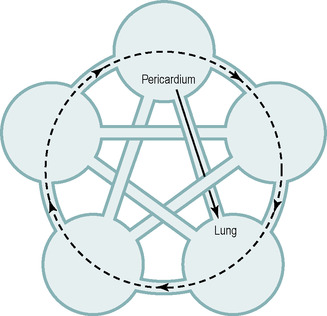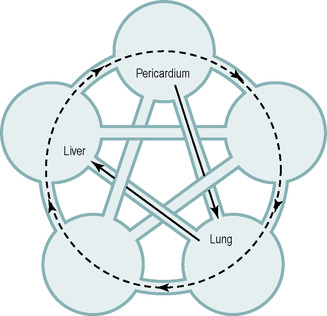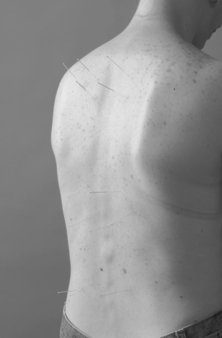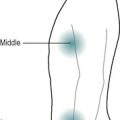30. Aggressive Energy
Chapter Contents
What is Aggressive Energy?236
Diagnosis of Aggressive Energy238
Testing and treating Aggressive Energy240
What is Aggressive Energy?
Its nature
Aggressive Energy is described as qi ‘which has become contaminated or polluted’ (Lavier 1966; Worsley, 1990, Chapter 6, p. 175). Aggressive Energy can also be described as evil or unhealthy (xie) qi as opposed to upright or healthy (zheng) qi. (This was first suggested by Flaws, 1989.)
The contamination caused by Aggressive Energy can severely affect a person’s health and well-being. Physically it may cause life-threatening or debilitating illnesses. Aggressive Energy can affect a person’s mind and spirit and can cause symptoms such as instability, depression, despair or fluctuating emotional states. The treatment of Aggressive Energy can have a dramatic effect on the patient’s body, mind and spirit, enabling them to be restored to better health.
How Aggressive Energy develops
Once Aggressive Energy is present in one or more of the Organs, it is hard to expel without treatment. Healthy (zheng) qi naturally flows from Organ to Organ along the sheng cycle – the nurturing cycle of qi (see Chapter 2, this volume). Aggressive Energy is not healthy so it does not travel along this cycle. Instead it travels along the ke cycle. The ke cycle is usually translated as the ‘control cycle’ but when Aggressive Energy is present in the system the ke cycle becomes a destructive cycle. The yin Organs are connected across the ke cycle and this qi travels across it from yin Organ to yin Organ. Aggressive Energy is not usually found in the yang Organs.
Su Wen Chapter 65 describes how disease travels across the ke cycle:
If a disease first develops in the Heart, there will be cardiac pain. One day later it reaches the Lung, causing dyspnoea and cough. Three days later, it reaches the Liver, causing propping fullness in the (free) rib region. Five days later, it reaches the Spleen, causing blockage and stoppage, generalised pain and heaviness. If it is not cured within three days, the condition is fatal.
(Huang Fu Mi, translated by Yang and Chace, 1994)
If two Organs across the ke cycle have Aggressive Energy present, it is said that one ‘leg’ of the ke cycle is affected (see Figure 30.1). For example, if a person has Aggressive Energy on the Pericardium, this Organ may pass it on to the next Organ along the ke cycle – the Lung. If both the Pericardium and the Lung are affected this forms one ‘leg’ of the cycle.
 |
| Figure 30.1 • |
The Lung will then attempt to throw off this unhealthy or evil (xie) qi but it may be transmitted to the Liver. If the Pericardium, Lung and Liver all have Aggressive Energy, then two ‘legs’ are affected (see Figure 30.2). The more Organs that are affected the more serious the condition for the patient (see Figure 30.3).
 |
| Figure 30.2 • |
 |
| Figure 30.3 • |
The aetiology and pathology of Aggressive Energy
Aggressive Energy can arise from an internal or an external cause.
Aggressive Energy from an internal cause
If Aggressive Energy comes from an internal cause, an emotional trauma is usually the initial trigger. This can be anything from relationship problems, financial worries, work difficulties, family concerns or shocks. Under normal circumstances people recover from the effects of these stresses. When patients have had intense and repetitive emotions over a long period of time, however, this tends to cause disease, especially if the emotion is not expressed and has created stagnation.
In Chinese medicine emotions are called the internal causes of disease because they arise from inside us. Emotions that are not resolved eventually stagnate. As with all stagnation, this may eventually turn to toxic heat or fire. This may accumulate within an Organ as Aggressive Energy.
Mantak Chia, a qi gong teacher, describes heat in the Organs in the following way:
… each organ is surrounded by a sac or membrane, called fascia, which regulates its temperature. Ideally the membrane releases excess heat out through the skin, where it is exchanged for cool life force energy from nature. An overload of physical or emotional tension causes the membrane, or fascia, to stick to the organ so that it cannot properly release heat to the skin nor absorb cool energy from the skin. The skin becomes clogged with toxins and the organ overheats.
(Chia, 1985, p. 71)
During the initial case history a patient admitted that he had been unable to forgive his wife after she’d had an affair many years before. He continually felt angry towards her in spite of the fact that she had been committed solely to him for many years. Years of chronic resentment and hurt had led to Aggressive Energy that was drained from his Pericardium, Lung and Liver. Following this he felt able to forgive her and was stunned that the simmering anger he’d previously felt towards her had disappeared.
Aggressive Energy from an external cause
Evil or unhealthy (xie) qi derives from the external pathogenic factors of Wind, Cold, Damp, Dryness, Fire or Heat and can arise from inside or outside the body. The cause of a pathogen entering the body from the outside is often a climatic condition which ‘invades’ the body. It can also arise internally after an Organ becomes weakened or a drug or a vaccination has been administered. This causes a pathogen such as Heat to form in the body. (For more about ‘latent Heat’ and ‘residual pathogenic factors’, see Maciocia, 2008, pp. 1133–1139.)
If the patient’s healthy (zheng) qi is strong, then the pathogen is normally thrown off or dealt with. Having evil or unhealthy (xie) qi inside the body will not in itself be a cause of Aggressive Energy. Over time, however, if a pathogen is not thrown off by the body’s healthy (zheng) qi, it may penetrate deeper into the body. Finally it will reach the yin Organs. This is the deepest place that it can reach, so it stays there and stagnates. Over time, accumulation or stagnation turns to Heat and this unhealthy or evil (xie) qi may become toxic heat or fire in the yin Organs. It has now become Aggressive Energy.
Su Wen alludes to this when it describes disease penetrating deeper and deeper into the body in Chapter 5:
It is best to treat diseases at the level of the skin and hair; the next best is to treat them at the level of the muscles and flesh; the next best is to treat them at the level of the sinews and vessels; the next best is to treat them at the level of the six yang organs; the next best is to treat them at the level of the five yin organs. When treating the level of the five yin organs half the patients die and the other half survive.
(Su Wen Chapter 5; translation from Bensky and Barolet, 2009, p. 4)
Aggressive Energy and the CF
Pathogens can only invade the system if the upright (zheng) qi is weak. If a person’s qi becomes weakened, it is usually the Organ of the CF that is the first to be affected. Correspondingly, the first Organ to be affected by Aggressive Energy is likely to be the
A patient came for a treatment and was treated on Wood, which was his CF. That evening there was a violent storm and he went up on his roof to secure his TV aerial. As it was very windy, he was there for quite some time. The next day he woke up with burning pain in every joint and he couldn’t move. He had normally been athletic and healthy and now could only shuffle. The patient rang his practitioner, who visited him at home. The practitioner noticed that he had a floating quality on his Liver, Spleen and Kidney pulses and that all the pulses were extremely deficient. The practitioner checked for and drained Aggressive Energy from the Liver, Spleen and Kidneys. After it was drained the burning went immediately. He also felt much better in himself and knew that he was no longer in a crisis. It took him another two weeks to fully recover normal movement.
yin Organ related to the Element of the CF. In the Fire Element, Aggressive Energy is more commonly found on the Pericardium than the Heart. This is because the Pericardium normally protects the Heart from Heat and Fire. As it says in Ling Shu Chapter 71:
If the Heart is attacked by a pathogenic factor, the shen suffers, which can lead to death. If a pathogenic factor does attack the Heart, it will be deviated to attack the Pericardium instead.
(quoted in Maciocia, 2005, p. 165)
Diagnosis of Aggressive Energy
Aggressive Energy can be a difficult pattern to diagnose, as there may not always be specific signs and symptoms manifesting. Certain general predisposing circumstances can, however, lead the practitioner to suspect its presence.
Factors that may indicate the presence of Aggressive Energy
The main indications of Aggressive Energy are:
• a serious or life-threatening physical illness
• severe mental or spiritual problems
• unexpected or unusual aggravations to treatment
• a history of intensive drug therapy or addictions to alcohol or recreational drugs
• signs of colour, sound, emotion or odour which resonate with two Elements across the ke cycle
• chaotic or unstable pulses
Life-threatening or serious physical illness
If a patient has a long-term chronic illness, Aggressive Energy may have either developed from the disease or it may itself have caused the severe debilitation. A practitioner should test for Aggressive Energy if a patient has any severe illness or degenerative condition, or any signs and symptoms that seem extreme or in any way strange or bizarre.
Severe mental or spiritual problems
People with Aggressive Energy may describe having feelings such as desperation, hopelessness, despair or resignation. Some patients have a sense that they are unwell but feel unable to verbalise what is wrong. This level of internal distress may seem disproportionate to the person’s description of their health.
Unexpected or unusual aggravations to treatment
On some occasions a patient has extraordinary reactions to treatment and feels worse rather than better. Obviously an aggravation can occur if the patient has
A patient was transferred to the student clinic from another practitioner. She was not checked for Aggressive Energy. The patient was diagnosed as a Fire CF and her Pericardium and Triple Burner were treated. She had an aggravation after this treatment, describing feeling tired and depressed as well as having a headache. The practitioner checked for Aggressive Energy and found it on the Kidneys and Pericardium. After it had been cleared the treatment progressed as expected.
been incorrectly diagnosed and treated, but if it happens for no obvious reason it may suggest that the practitioner should test for Aggressive Energy.
A history of intensive drug therapy or addictions to alcohol or recreational drugs
Any kind of drugs (prescribed or non-prescribed) that are used consistently eventually cause toxicity in the system. This is especially the case if medicines are used to suppress or alleviate a symptom without treating the underlying cause. Many recreational drugs, such as cocaine, amphetamines, ecstasy, LSD or the opiates, easily give rise to Aggressive Energy. Drugs given over long periods of time may eventually stagnate in the Organs and turn to toxic heat.
A patient with long-standing asthma was given large doses of corticosteroids after an asthma attack. The patient’s asthma improved but he felt as if all of his enjoyment of life had disappeared. Aggressive Energy was found on the Kidneys. After it had been drained his spirits returned to normal.
Signs of colour, sound, emotion and odour resonating with two Elements across the ke cycle
A patient may be yellow and singing, fearful and putrid – indicating that both the Water and Earth Elements are out of balance. Alternatively, the patient may express grief and weeping whilst looking green and smelling rancid, indicating that Metal and Wood are both imbalanced. If two Organs across the ke cycle are affected, the practitioner should always consider that Aggressive Energy may be present.
A patient told his practitioner, ‘When I look into the future, I can’t see my life continuing. It’s like pulling a roller blind down.’ The patient looked green and his inability to see any future also alerted the practitioner to the fact that the Liver was out of balance. The patient was also weeping and displaying signs of grief. The practitioner found Aggressive Energy on the Lung and Liver.
Chaotic or unstable pulses
Although there are no special pulse qualities associated with Aggressive Energy, some pulse qualities may be more indicative than others. Someone with Aggressive Energy may have ‘erratic’ or ‘unstable’ pulses. Pulses have also been described as having ‘significant signs of pulse unrest’ and ‘which strike us as far more serious than only a mere inconsistency’ (Worsley, 1990, p. 176). These pulse qualities may sometimes be felt on the Organs across the ke cycle that are affected by the Aggressive Energy, for example, on the pulses of the Spleen and Kidney or the Liver and Lung.
Testing and treating Aggressive Energy
When to check for Aggressive Energy
The practitioner can test for Aggressive Energy whenever several of the conditions listed in the diagnosis section above are present. It is often tested for at two stages of treatment:
1 at the beginning of treatment
2 during treatment if there is a failure to respond to treatment or a downturn in the patient’s condition
At the beginning of treatment
Aggressive Energy may be present without obvious signs and symptoms manifesting, so a practical option is to always test for it during the first treatment. If Aggressive Energy is present and is not cleared at this stage, then it could be spread to different Organs or be driven deeper into the body. This is most likely to happen when qi is transferred via the sheng and ke cycles, during subsequent acupuncture treatments.
During the course of treatment
Aggressive Energy should always be checked if a patient doesn’t respond to treatment or has an unexpected decline in health during the course of treatment. In this case the patient may already have had Aggressive Energy that had not been found at the start of treatment. Alternatively she or he may have had some stress or trauma which caused the Aggressive Energy to form during the course of treatment.
The testing process
Position of the patient
Patients are usually sitting with a relaxed yet straight back. Their arms are supported in their lap. It is important that the patient is upright. In this position the back is opened up and the points are accessible. If the patient slouches forward, then the rib spaces move up in relation to the intervertebral gaps. In this case the anatomical descriptions of the point locations need to be adjusted.
When inserting needles it is preferable to have the patient supported because of a slight possibility of needle shock causing the patient to faint. This is rare but can happen when Aggressive Energy is checked, as needle shock is most likely to occur during the first treatment (for more on needle shock, see Chapter 34). To support the patient, place a chair sideways against a treatment couch. Patients can either fold their arms loosely in their lap or rest their hands on the couch.
On the rare occasions that a patient faints while Aggressive Energy is being checked, it is best to test again at the next treatment but with the patient lying down in a prone position. In this case the practitioner should ensure their arms are stretched out to the sides to open up the space between scapula and the spine. The upper thoracic rib spaces are located slightly higher in this position than when the patient is sitting up.
The testing process
To check for the presence of Aggressive Energy, needles are placed in the back shu points. Aggressive Energy is found in the yin Organs of the body. These shu points connect directly to the yin Organs and are used for ‘draining’ the Aggressive Energy. ‘Draining’ is the term used when the practitioner finds that Aggressive Energy is present and treats it by leaving the needles in. To test for Aggressive Energy:
• insert needles into the back shu points of the yin Organs, i.e. Lung, Pericardium, Liver, Spleen and Kidney (not the Heart). Leave the needles in place
• place a unilateral ‘check’ or ‘dummy’ needle about an inch away from each level of back shu points and at the same level and depth. Leave these needles in place
Figure 30.4 shows the needles in place on a patient who is being tested for Aggressive Energy (Table 30.1).
 |
| Figure 30.4 • |
| Point | Back Shu point of which Organ |
|---|---|
| Bl 13 | Lung |
| Bl 14 | Pericardium |
| Bl 15 | Heart (only if necessary) |
| Bl 18 | Liver |
| Bl 20 | Spleen |
| Bl 23 | Kidney |
Needle depth
When testing for Aggressive Energy the needles are inserted just under the surface of the skin to a depth of approximately 0.1 cun. This superficial insertion helps to draw the Aggressive Energy from the Organs at the same time as ensuring that it is not driven deeper into the body. If the needles are inserted more deeply they are likely to have a slight sedating effect on the Organs, which is not the intention of the treatment.
Testing the Heart
It is best not to place needles in the back shu point of the Heart unnecessarily for two reasons. Firstly, the Pericardium is the protector of the Heart, so if the Fire Element has Aggressive Energy the Pericardium will usually be affected rather than the Heart. Secondly, long-term retention of needles could unnecessarily drain the Heart qi.
The practitioner should test the Heart if:
• Aggressive Energy is present on the Pericardium – in this case it may also be present in the Heart.
• Aggressive Energy is present on the Kidney and Lung but not on the Pericardium. In this case the Aggressive Energy is on two legs of the ke cycle and may have travelled through the Heart rather than the Pericardium.
• The Heart pulse or Heart signs and symptoms show disturbance as on rare occasions sometimes Aggressive Energy can be present on the Heart alone.
Signs of the presence of Aggressive Energy
Aggressive Energy is present if:
• an erythema (reddening of the skin) appears around the main needle and not the check needle. This indicates the presence of Aggressive Energy in the Organs. The erythema may be present for anything from 30 seconds to one hour
• there are significant changes in the patient’s pulses or colour, sound, emotion and/or odour.
Aggressive Energy is not present if:
• no erythema appears round any of the needles
• the erythema is the same or more on the check needles than on the needles in the back shu points
• there are few or no changes in the pulses or colour, sound, odour and emotion
Procedure if Aggressive Energy is present
If Aggressive Energy is suspected, leave the needles in place until all of the erythema disappears in order to fully clear the Aggressive Energy from the Organs.
Sometimes Aggressive Energy may be cleared in 10 or 20 minutes or less, but there are other times when it can take up to an hour for the erythema to disappear. It is important that the needles are not removed until all the erythema has cleared or some of the toxicity will be left in the body.
Aggressive Energy is not a common condition and is found in approximately 1% of patients.
Possible causes of erythema that are not Aggressive Energy
Sometimes an erythema arises on the skin but it is not Aggressive Energy. There are several reasons for this.
Sensitive skin
Pale-skinned people are likely to have more reactive skin than people with darker skin or hair. The presence of a dummy needle which is not in an acupuncture point ensures that a reddening due to skin sensitivity is not mistaken for Aggressive Energy.
Too many needle insertions in a small area
If a needle seems to be slightly misplaced on the first insertion the practitioner may wish to remove it and place it in a new position or insert another needle close to it. Inserting additional needles ensures that the correct point has been needled so that all Aggressive Energy is removed. At the same time, the additional insertions may cause the skin to react and become redder and give a false indication of Aggressive Energy.
Other congestion or toxicity
Erythema can appear around a needle if there is tightness, spasm or heat in the underlying muscles rather than in the organs.
Reactions to treatment
After Aggressive Energy has been removed from the patient’s system she or he will generally report feeling different. Sometimes this can be dramatic. Often the patient reports feeling ‘better in myself’ as well as a significant improvement in symptoms at the next treatment session. Sometimes a patient feels very tired immediately after treatment followed by a feeling of being re-energised. Signs and symptoms vary according to each individual patient.
A patient was being tested for Aggressive Energy in a student clinic. His face looked puffy and red and he was so angry he looked ready to explode. Fifteen minutes later, on opening the door of the treatment room, the supervisor momentarily thought he was in the wrong room. He had failed to recognise the patient, who had changed dramatically. He now looked somehow smaller and paler, calm and quiet.
Subsequent treatment
If a patient has Aggressive Energy it is best to re-check at the next treatment to ensure that it has all been cleared. Sometimes more Aggressive Energy comes up after the first draining. This is unlikely to happen more than once or twice provided that it has been fully cleared at each treatment.
As long as no other blocks are present, regular treatment can continue after all Aggressive Energy has been cleared.
Summary
1 Aggressive Energy is a form of unhealthy (xie) qi. Its cause can be external or internal and the resulting stagnation usually turns to heat and is then trapped in the yin Organs.
2 Aggressive Energy travels between the yin Organs connected along the ke cycle.
3 The presence of Aggressive Energy can cause severe and possibly life-threatening illnesses.
4 Aggressive Energy is checked by placing needles in the back shu points of the yin Organs. It is present if an erythema appears around the needles (but not the ‘dummy’ needles). The needles are then left in place to drain the Aggressive Energy. When the erythema disappears the Aggressive Energy has been cleared.
5 If Aggressive Energy has been present the patient experiences significant improvement in health and the pulses and/or colour, sound, emotion and odour often change as a result of the treatment.





